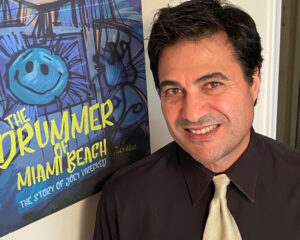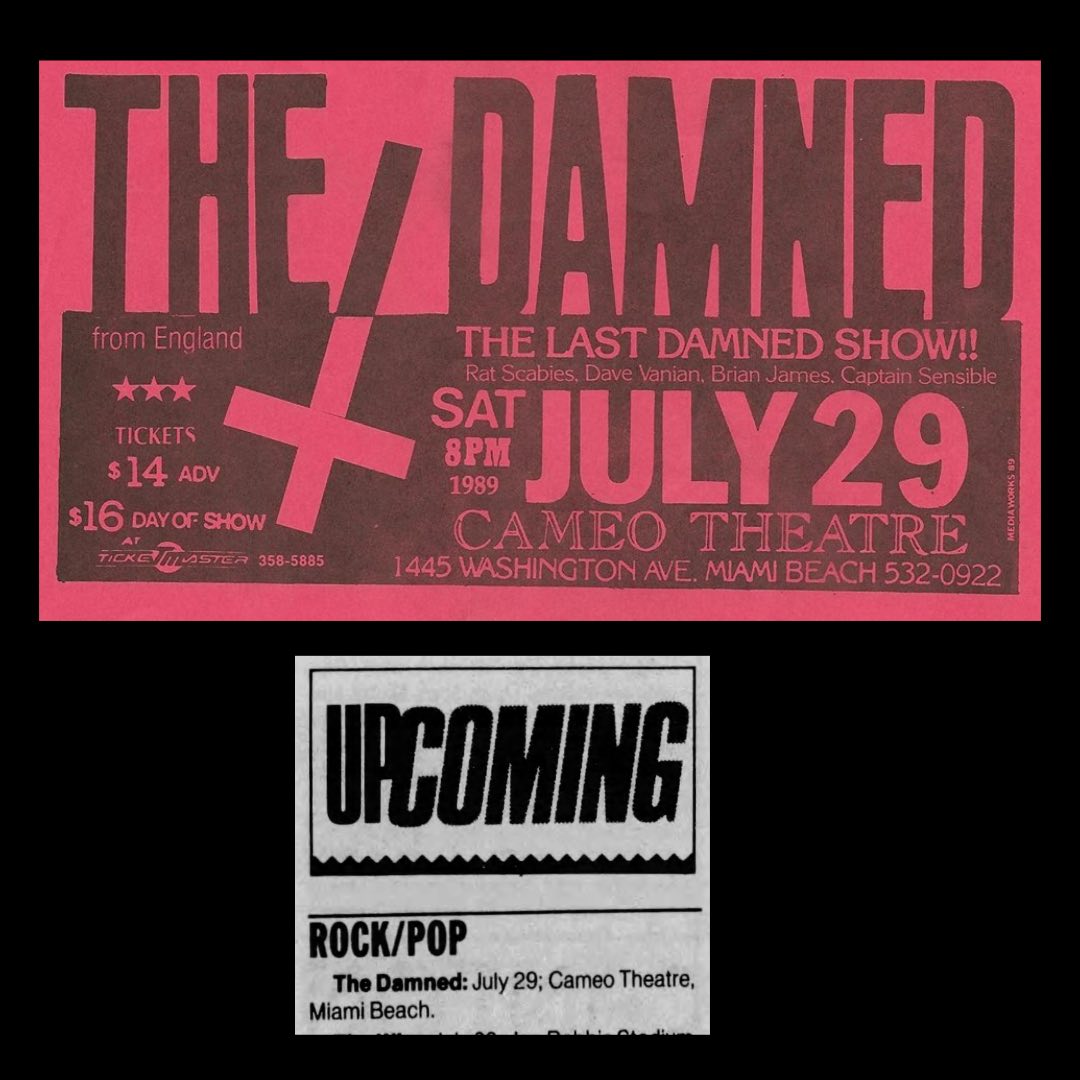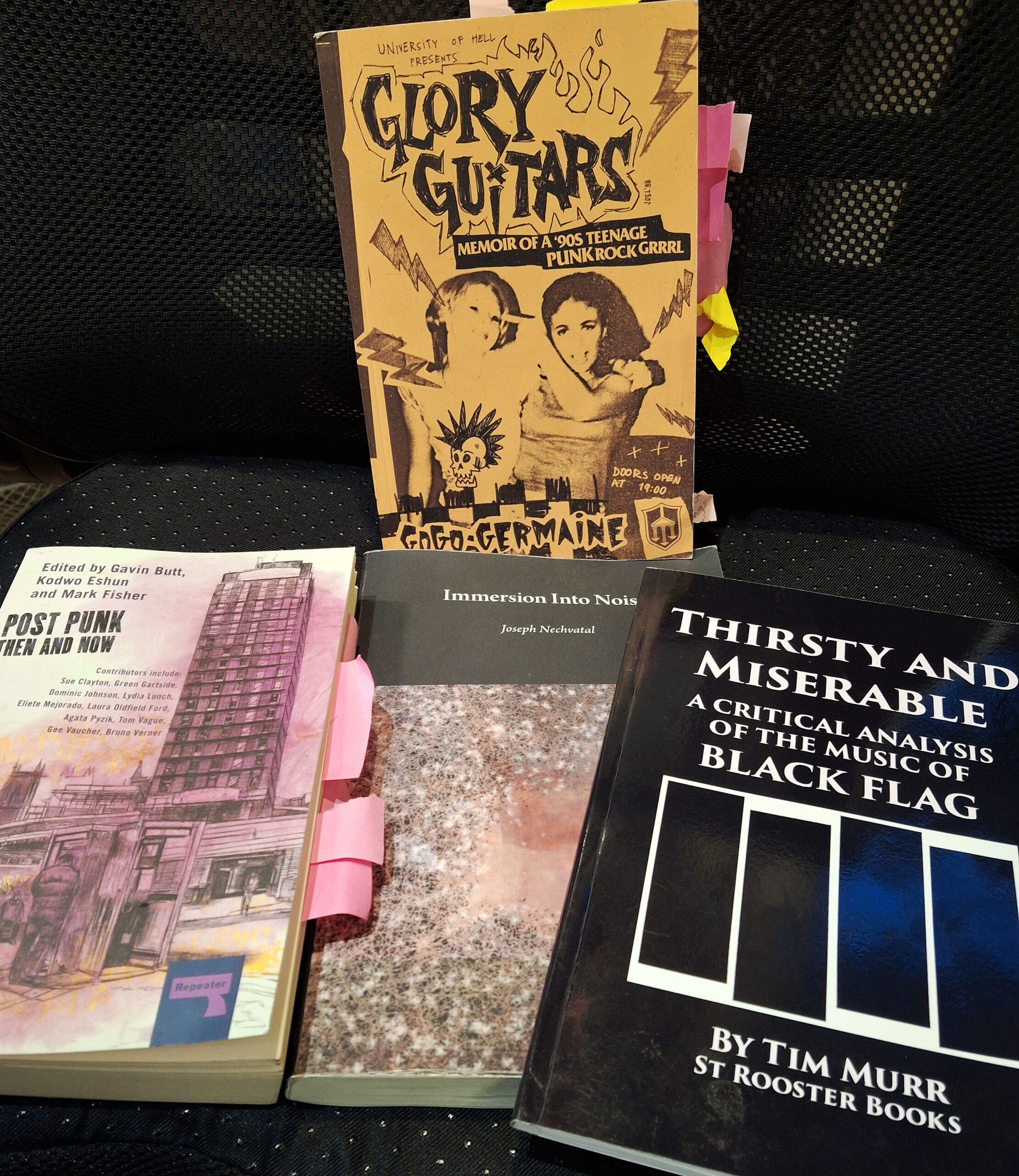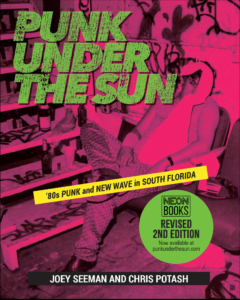
Here are brief bios–in their own words–of our cool guests that you’ll meet in person on Saturday, November 23, at 11 a.m. at the 2024 Miami Book Fair if you join us for the panel discussion “MIAMI UNDERGROUND: WHAT WE DID IS SECRET.”
Emile Milgrim, founding member of the present-day Miami-based band Las Nubes
“Music–practically all music–struck a chord (ha!) with me at a very young age. “Mainstream” radio in 1980s-1990s Miami was a special place since you could hear things like freestyle and bass music alongside national rock and pop staples. Many public places you went were playing “Latin” music before it was lumped into that generic grouping, so those various rhythms worked their way into me as well. I never considered genre or style, I just knew what felt “right” to me. This take on things would get me made fun of in middle and high school, mainly by the alternative/punk kids I really wanted to be friends with. I’ll never forget all the crap I got for being OBSESSED with Fleetwood Mac in the mid ‘90s when they, as far as I recall, weren’t relevant to any demographic, let alone 13-year-old closeted queer kids.
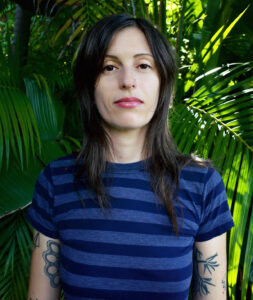
Eventually though, through the magic of an internet in its infancy, I’d find my people at around age 15: genre-fluid kids like me, chatting on IRC about bands, producers and DJs, past and present, local and beyond. We shared everything we could with each other, often in person since someone had to play you a tape, record, or CD, or there was a band playing at a house party, or Cheers, or Churchill’s. And sometimes we’d make it up to Broward or West Palm in someone’s rickety Ford Escort barely held together by duct tape, just like our wallets were. Music was the way I first experienced capital-C community, and it would dictate the course of my life.
“As many folks from South Florida do, I left after college, moving to Portland, OR, a well-known DIY/punk haven. Out there I eschewed grad school after one semester to play in experimental bands while also helping promote/book other small bands and artists, eventually starting a tiny record label, Other Electricities, that I still run today. When I returned to Miami in 2011 for family reasons, one of those kids
I’d met online in the ‘90s asked me if I wanted a job at her record store, Sweat. I worked there for 11 years and throughout that same timeframe, and much due to that space and Miami’s local music community, I met friends, collaborators, and ultimately, much of my chosen family.
“This is what music can do. This is why we get in a van and drive eight hours to sometimes play to only five people. Once upon a time we WERE those five people and THAT BAND changed our lives. Now I’m in my forties and occasionally folks will ask why I ‘still’ do this. Honestly, I don’t know how to not do this. I can’t imagine not being part of a local, and now–thanks again, internet–global community of creators, performers, teachers, scholars, fans, curators, and appreciators of this magical thing that always has and will continue serving as a grand unifier. It will forever just feel ‘right.’”
Howard Davis, founder of the 1980s artist group Artifacts
“I grew up in Montréal, Canada and after obtaining my B.A. in Art History was living and working in London, England, in the late 1970s at the same time my mother, Joy Moos, an art gallery director, moved her home and business to South Florida.
“I was 27 when I arrived in Miami in 1980 for a visit in the wake of the McDuffie riots and in the midst of the Mariel boat lift. I found a good job at the Fountainbleau Hotel, decided to stay for a while, and began exploring the night life. Having been exposed to the tidal wave of new musical expressions in England in the late 70’s from disco to punk to ska to New Wave to dub-style reggae and early hip-hop, I was disappointed that the first clubs I visited in Miami played strictly top-forty tunes. I eventually discovered more alternative venues like the New Wave Lounge in Fort Lauderdale, Flynn’s in North Miami Beach, Salvations in downtown Miami, and others. Meanwhile, sometime in 1982 I heard an appeal on WDNA, Miami’s local volunteer radio station, for disc jockeys and jumped at the opportunity to play music that I became familiar with in London.
“I began to accumulate a record collection, and I started to approach managers and owners at various clubs to offer to promote and DJ an “alternative” night. I printed flyers, and with the enthusiastic support of independent book and record stores (including Books and Books, Open Books and Records, Yardbird, Yesterday and Today and Blue Note) I was able to get the word out from South Miami to Fort Lauderdale.
“Whether my own event or someone else’s, the majority of people I met described themselves as artists, and that inspired me, in 1984, to approach Don and Bill, the new owners of Fire & Ice, and propose that if they gave me an “off” night I would to create a showcase for emerging artists. We settled on Tuesdays. I called the event “Artifacts,” which began with a group show–largely thanks to the support of the respected and enthusiastic artist Germaine Brooks and her extensive group of artist contacts–in June ’84. Forty to fifty artists submitted work for the first show, and several hundred people attended. A core group of artists gravitated to the weekly event, and although no one was paid–or more likely because of that–the opportunity to collaborate and create remained the key motivating factor for transforming the expansive interior of Fire & Ice on a weekly basis throughout our two-year run there.
“Concurrent with the Artifacts showcase were three summer group shows featuring artists from Artifacts as well as other contemporary artists represented by Joy Moos at the Moosart Gallery in Miami’s Design District. “Get Fresh” (1984), “Burnt Toast” (1985), and “Word Up” (1986) reflected the zeitgeist of the era and provided a commercial outlet for many artists from the Artifacts Artist Group. The eighties was a time of great artistic creativity among artists in all media worldwide, and I took inspiration from publications such as the Face, New Musical Express (NME), and ID Magazine in England and Details and East Village Eye in New York, among others. Another prominent gallery in the Design District back then was Barbara Gillman. Other galleries included Gloria Luria and Fred Snitzer.
“The growing art scene in the ‘80s and ‘90s was supported by many stellar newspaper journalists and critics from the Miami News, Miami Herald, and the New Times, including Paula Harper, Chris Potash, Elisa Turner, Jordan Levin, and Helen Cohen.
“One of the first venues of the 1980s resurgence of South Beach was the Strand at the Living Room on Washington Avenue that combined a theater space and an upscale restaurant.
“The Bass Museum and the art museum at Florida International University (FIU) South as well as the CFA were pillars of the burgeoning ‘80s/’90s art scene, as was the Miami-Dade Public Library, where Barbara Young organized art exhibits and installations and introduced the community to the unique and prolific work of self-taught, now celebrated artist Purvis Young from Overtown.
“Don Chauncey from the same Library oversaw the highly respected 16mm Film Collection of avant-garde films from the 1920s forward.
“Among the many highly regarded educators of that era from Miami-Dade Community College, the University of Miami, and FIU were Charles Recher (film), Marilyn Gottlieb-Roberts (multimedia), Tony Allegro (film), and Manny Torres (art history).
“Then, then there was Wet Paint on the mainland, a couple of disintegrating but still stately former mansions on Biscayne Bay occupied by Rodolfo Tejera and Davis Murphy, both brilliant and influential artists, that became the venues for anarchic art happenings involving flame throwers (“Product Sacrifice” in association with a NY gallery), various objects including a Ferrari and a refrigerator half-buried in the yard, punk bands, and unrestrained pandemonium.
“In 1985 the Artifacts Art Salon opened on Michigan Avenue, just off Lincoln Road, which was practically deserted at that time except for Elie Schneidermann’s South Florida Art Center, which consisted of a main-gallery building and many satellite studios. In 1986, Interview Magazine devoted an oversized issue to the emergence of the Miami 1980s art, fashion, and music scene, and I had the good fortune to meet Robert Becker, the arts editor for Interview, and convinced him that Artifacts Artist Group consisted of artists at the forefront of the new era. He wrote a lengthy article highlighting half a dozen creative artists (including Damian Rojo, the art director of Artifacts), and had each of them design a border which surrounded the pages of the article. Robert told me later that Andy (Warhol) told him that he loved the contents of the article and the design of the pages.
“The 1980s and ‘90s were a cauldron of bubbling new ideas and approaches to art, a time of great excitement and creativity both locally, nationally, and globally. The Miami art scene felt unconstrained and brimming with potential.
“Though it may have seemed unlikely to the casual observer at the time due to Miami’s superficially “laid back” tropical guise, the story of Artifacts in the 1980s coincides with the beginning recognition of Miami’s significance as a world-class cultural destination.
“Collaboration, interaction and the experiential nature of art were the founding principles of Artifacts. Weekly group-determined themes provided the framework for transformative installations combined with performance art, fashion shows, poetry, and more at Fire & Ice nightclub.
“Acknowledging the significance of the Artifacts Artist Group in art history, the University of Miami has established a special collection dedicated to Artifacts Artist Group documentation and artworks, ensuring their preservation and availability for further study.”
Joey Maya, author of The Drummer of Miami Beach
Hear Joey talk about his memoir in his own words in this awesome podcast from the Jitney: Joey Maya on The Drummer of Miami Beach